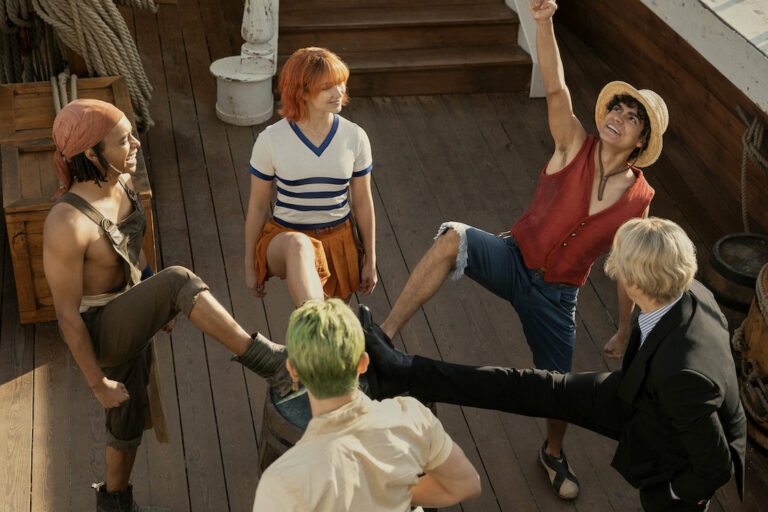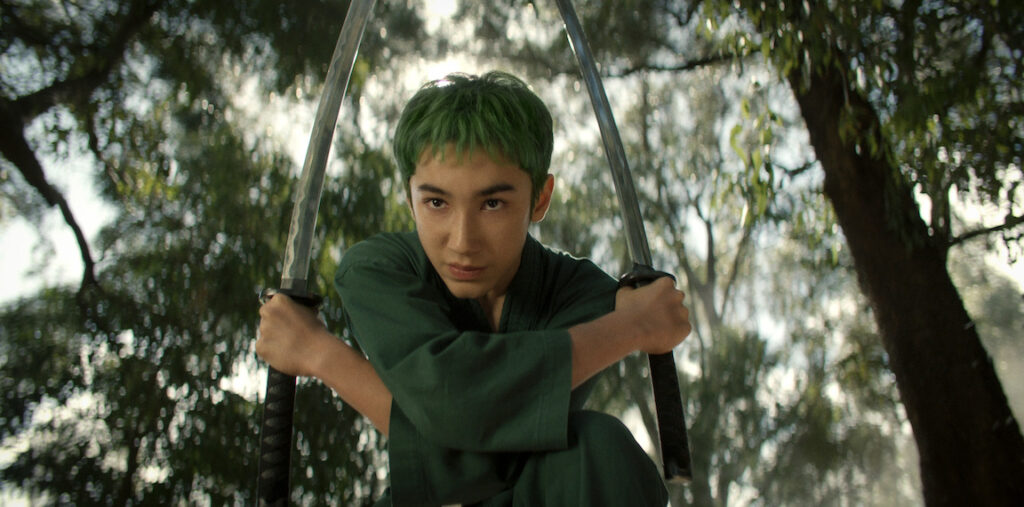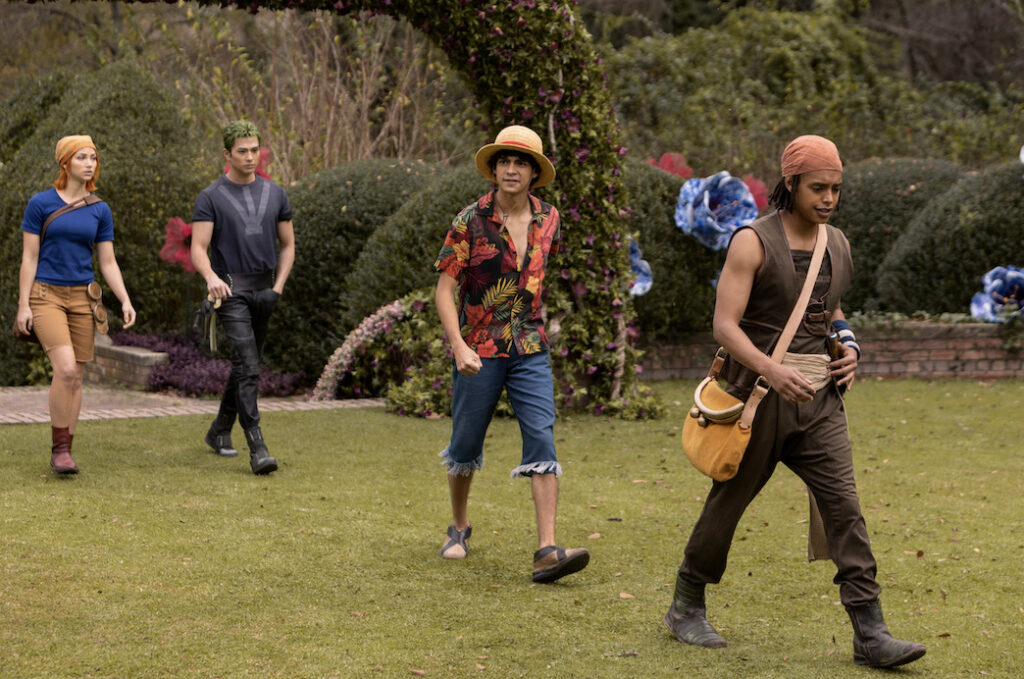
Synopsis : Monkey D. Luffy and his pirate crew explore a fantastical world of endless oceans and exotic islands in search of the world’s ultimate treasure to become the next Pirate King.
Creator: Eiichiro Oda
Starring: Iñaki Godoy, Mackenyu, Emily Rudd, Jacob Romero Gibson, Taz Sylar
TV Network: Netflix
Premiere Date: Aug 31, 2023
Genre: Fantasy
Executive producers: Marty Adelstein, Becky Clements, Eiichiro Oda, Matt Owens, Steven Maeda

Exclusive Interview with Director Emma Sullivan
Q: You made a short film called “After Tomorrow” which was nominated for the Palme dOr for the Best Short at Cannes in 2009. Is that what led producers Matt Owen and Steven Maeda to hire you to direct these episodes? It seems such a transition, how did you get involved with “One Piece?”
Emma Sullivan: I did a few things in between, then and now. I started when I left film school and then did that film, which was fun, but it is a tough business as you know. I had to start at the bottom, directing a kind of afternoon entertainment in the UK and then just slowly build my way up. Then, I got to “One Piece” because I’d done “Doctor Who” and “The Watch.” I was beginning to get more skillful with telling stories that are kind of more fantasy. That’s the natural kind of link between those series.
Q: What was your relationship to Eiichiro Oda’s original manga — which elements of Oda-san’s manga that fascinated you and made you decide to tackle this project?
Emma Sullivan: One of the things is that my son is a fan, but I didn’t know about it. When I told my son that this is a show about a rubber pirate, he said: “One Piece.” Look of his face…you have no idea how big it meant for him. Finding out from him how much it meant to him and then finding out that all my nephews have read it made me realize how loved it is. It’s an honor to be able to do it. And when I meet the people who know the manga, it’s quite daunting as well. You think, “Oh my goodness, I just need to make sure that I need to get Oda-san’s vision is done correctly.”
Q: Speaking of vision, there’s literally eight writers who are credited, including the manga’s creator Eiichiro Oda. In order to bring it from the page to the screen for the two episodes you directed, three and four, what conversations did you have with the writing team and did you stress anything specifically to be in the storyline?
Emma Sullivan: I didn’t get to meet [manga creator] Eiichiro Oda, but I would have loved to have met him. I really wanted to go to Japan, that’s my first pitch, can I go? But our show runners, Matt Owens and Steven Maeda met Oda-san, they had a conversation with him, they were the ones with the vision and they delivered it to us because they’re both huge “One Piece” fans.

Q: Did Oda-san specifically request a certain thing? How did you translate certain things from the original manga to the screen?
Emma Sullivan: Okay… For example, there’s a scene in one of my episodes between young Zoro and Kuina in Shimotsuki Village. They have this fight. Oda-san watched it and he wanted us to redo it because we did it with Kendo masks on. So we went back to South Africa and did it again just to make sure he was happy with it. I think it’s just so important because it’s his life’s work. We have to make sure he’s happy with it.
Q: How much were you involved in the casting process of each character? Particularly, the character of Luffy. What was Iñaki Godoy’s personality that fascinated you guys? Talk about handling that process with the producers.
Emma Sullivan: I wasn’t involved in the casting. Unfortunately, I came in late to the production. By the time I arrived, everybody had been cast. But it is uncanny how Luffy [the actor] Iñaki actually is — he’s full of positivity and enthusiasm like his character, Luffy. I think they searched everywhere for these people and they’re all very close to their characters.
Q: What was amazing about this show is that all the Straw Hat crew members go the extra mile to protect and support each other. That’s very important. How did your team of directors create that bond between the actors? To do a lot of rehearsal or get together in meeting?
Emma Sullivan: I always like to meet the actors beforehand and, obviously, there’s a lot of rehearsals going on for the action sequences in particular. You know, I also think there is a camaraderie on set as well, from what we see as an audience, we see it’s the actors, you think of the director [pulling the strings], but there are hundreds of people as well as all the crew in the background. Everybody’s pulling together to make these incredible sets and tell this incredible story. We have the story of Straw Hat, but also we are all filmmakers. Our crew worked very closely together on this idea of working together.

Q: You directed the episode 3 and 4, some of the fight sequence with Mackenyu at the Kaya’s house, it kind of reminds me of another live action from that based on manga, “Rurouni Kenshin,” what kid of conversation did you have with the fight choreographer to create these dynamic action sequences?
Emma Sullivan: We had this amazing fight choreographer who worked particularly with katanas. We had Franz [Spilhaus] and Darrell [McLean], and had Koji Kawamoto(“John Wick : Chapter 4” and “Kingdom”) who’s a specialist with katanas. When you watch him, it’s like watching fireworks. He’s so incredible with his control and skills but he’s obviously the nicest man as well at the same time. And [actor] Mackenyu can do it, he really can do all the fighting. He loves doing those things. He’s so happy when [it’s] a fight day because there’s nothing he likes more than to just run around being a badass. Those scenes are just a huge pleasure, but you know that you’re also watching an amazing amount of skill, but Koji-san is the best.
Q: What kind of conversation did you have with the production designer Richard Bridgland about creating the Kaya House and Going Merry Ship, which are straight out of Oda’s manga, it’s really authentic — it was really amazing to see it brought to the screen.
Emma Sullivan: We had themes within the Kaya’s mansion. There’s a lot of nautical things in the entrance hall — which are beautiful — and the stuff doesn’t even get on screen. There are star maps on the ceiling of that room. There are the ship builders, there are these big Trompe-l’œil paintings on the walls of the shipbuilders. Then we also have this theme that goes through everything like in the dining room — it has an incredible spread of food. Again, it’s all seafood and it constantly comes back to the ship building of the Syrup Village and the fact that Kaya’s family is there. That’s what their job is. It’s magical and the set designer goes into such huge detail. For example, in Kaya’s bedroom, there are pictures on the walls of Usopp and there’s a painting of Mary. There were actually things in the drawers for the actors to find. They’re creating a magical world.
Q: The double personality of the character Klahadore, performed by Alexander Maniatis, is really fascinating. Talk about letting him perform that way — of showing that things aren’t what they seem.
Emma Sullivan: I think Alex did lots and lots of work on his own. You would see him walking up and down the set in character just trying to make sure that he was getting it right.
Q: How did you get him to perform that way with a double personality?
Emma Sullivan: It’s quite an overwhelming thing to have him playing these characters. He was so committed and keen to do his best that when we did our last shot — once his scenes were done — he literally was shaking. I had to give him a big hug at the end because it meant so much to him to do that. But you have to have these conflicting emotions. You have to access something quite dark and then something that’s very controlled. It’s a lovely challenge for any actor because you can show your range — that you can do all these different things.

Check out more of Nobuhiro’s articles.
Here’s the trailer of the series.

